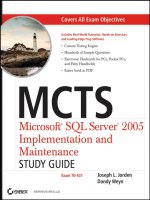Pronunciation Dictionary Study Guide
Bạn đang xem bản rút gọn của tài liệu. Xem và tải ngay bản đầy đủ của tài liệu tại đây (25.81 MB, 55 trang )
LONGMAN
PRONUNCIATION
DICTIONARY
STUDY GUIDE
Clare Fletcher
Longman ==:
rl.
Longman Group UK Limited
Longman House. Burnt Mill, Harlow,
Essex CM20 W E , England
and Associated Companies throughout the world.
Introduction
Part A: Pronunciations and variants
Longman Group UK Limited 1990
All rights reserved: no part of this publication may bereproduced.
stored i n a retrieval system, or transmitted in any form or by any
means, electronic, mechanical. photocopying, recording, or
otherwise, without the prior written consent of the Publishers.
1. Characters used in phonemic transcription
ISBN 0 582 05386.2
3. Alternative pronunciations
Set in Monophoto Gentury Schoolbook
Printed in Great Britain
by Richard Clay PLC., Bungay. Suffolk.
2. What pronunciations are given: the layout of entries
DIAGNOSTIC EXERCISE
ALTERNATIVES AT T H E BEGINNING O F A WORD
ALTERNATIVES AT THE END O F A WORD
ALTERNATIVES IN THE MIDDLE O F A WORD
COMBINATIONS O F ALTERNATIVES
ALTERNATIVE PRONUNCIATIONS INVOLVING T H E SYMBOL
QUIZ ON ALTERNATIVESPRONUNCIATIONS
4. Inflected and derived words
APPLICATION EXERCISES ON LAYOUT O F ENTRIES.
ALTERNATIVE PRONUNCIATIONS. INFLECTIONS AND
DERIVED FORMS
5. Optional sounds
SOUNDS SHOWN IN ITALICS: ELISION
SOUNDS SHOWN BY RAISED LETTERS:INSERTION
CONVERSATION FOR STUDY: OPTIONAL SOUNDS
6. Syllabic consonants
7. Compression
COMPRESSION INVOLVING A CONSONANT
COMPRESSION INVOLVING A VOWEL
CONVERSATION FOR STUDY: SYLLABIC CONSONANTS AND
COMPRESSION
Part B: Stress in words and phrases
8. Pairs of words with different stress
This study guide enables readers to make the best use of the
Longman Pronunciation Dictionary. The dictionary and study
guide together a r e a powerful aid to the study of English
pronunciation.
9. Stress marking
PRIMARY STRESS
SECONDARY AND PRIMARY STRESS
TERTIARY STRESS
MIXED PATTERNS
WHAT THE S T U D YGUIDE C O N T A I N S
10. Stress shift
Discussion of features of English pronunciation shown in the
dictionary and explanation of the conventions used to show
them.
Exercises to develop effective use of the dictionary.
Cross-references to relevant material in the dictionary's
introduction and notes.
Diagnostic exercises in the early sections to enable you to
assess your proficiency and select appropriate material.
Esplicit statements of aims to show the purpose of each
exercise.
A key a t the back of the book for checking the answers to
exercises,where these are not immediately obvious from the
dictionary.
11. Compounds and phrase's
12. Alternative pronunciations with different stress
13. Suffixes
Part C: Aspects of pronunciation in the dictionary
14. American pronunciation
SIX DIFFERENCES BETWEEN BRITISH AND AMERICAN
ENGLISH
QUIZZES ON AMERICAN PRONUNCIATION
TEXT FOR STUDY: AMERICAN PRONUNCIATION
15.Homophones
16. Abbreviations
17. Names of people and places
18. Assimilation
TEXT FOR STUDY: ASSIMILATION
19. Pronunciations derived by rule
20. Incorrect pronunciations
ex.76-77
ex. 7 8
The cassette provides three types of material:
Illustration of pronunciations you see in the book and
dictionary.
Exercises.
A means of checking your answers to certain exercises.
HOW TO USE THE STUDY GUIDE
You can work through the guide from beginning to end, or you
can plan your own programme to meet your needs.
Planning a programme
Look a t the Contents List.
Use the diagnostic exercises in the early sections.
Look a t the aims of sections and of specific exercises.
Select the sections and exercises which are useful for you.
21. Combining forms
Key to Exercises
vii
Using the commentary and exercises
It is always helpful to say the pronunciations you are reading.
to make them clear and to fix them in your memory. This may
not be possible, for example if you are working in a library.
But if you are working by yourself, or with others also using
the study guide, make a habit of saying the pronunciations.
Always look up pronunciations in the dictionary when you are
told to do so. In some exercises, the words to look up begin
with the same letter, to speed up the search.
Some exercises involve transcription; you can get further
practice by transcribing any of the dialogues and texts in the
book and cassette, and these are transcribed in the key a t the
back of the book.
Look up cross-references to the introduction or notes in the
dictionary, if you want to take a point further.
viii









